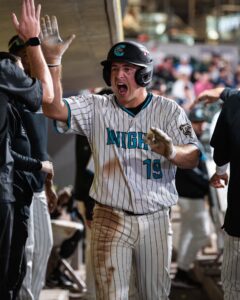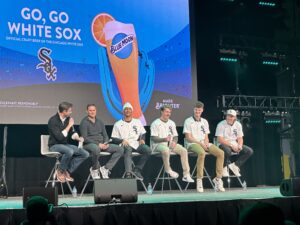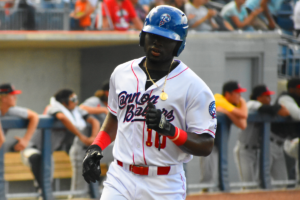Top White Sox Prospects, Midseason 2016: Players ranked 16-30
Twice annually, the writers at Future Sox work together to produce a list of the top prospects in the White Sox system. We use a voting system among the staff, then argue out specific players and rankings, until we come to a final list. The list is then released in two parts.
This is the “teaser”, where we release the back half of the list with player capsules for prospects ranked 16-30. The full list of top 30 prospects, with a more detailed overview, capsules for 1-15, and a list of players who just missed the Top 30, will be released later this week.
ELIGIBILITY: We consider a “prospect” any player in the White Sox organization who has not yet achieved MLB Rookie status.
HOW WE EVALUATE PROSPECTS: You can read this primer to get an idea of how we go about the sticky, subjective business of ranking prospects. Our writers saw every stateside affiliate live for multiple games in the past year, in addition to the back fields at Spring Training, fall instructs and the AFL.
STATE OF THE SYSTEM: The full list article will go into more detail on this, but here are a few key things to know. First, just one player from our last list has left the system: Tim Anderson, who has “graduated” to major league rookie status. Second, since our last list, the 2016 draft has occurred and injected much-needed talent. You’ll see lots of 2016 draftees on this and the full list. Finally, you’ll see a lot more prospects in this segment of the list have fallen than risen – this is mostly due to those new draftees, but also in some cases some disappointing performances from many prospects that jumped to the middle of the system on our last list. They jumped to the middle because the team had traded away many mid-ranked prospects last offseason. So in part, this is a correction of sorts.
FOR MORE DETAILS: If you click on the bolded player’s name, you’ll be taken to that player’s prospect profile, where you can find deeper details, links to videos and other content.
THE LIST (prospects ranked 16-30)
16. Jacob May, OF [Previous: 7th, -9]
- Drafted 3rd Round in 2013
Jacob May‘s 2015 started with him putting up strong offensive numbers in AA, but a scary collision and concussion took a bite out of the middle of his season. He returned later that year, but struggled at the plate. All this made it a mild surprise that the White Sox pushed him to AAA for 2016, and the relatively aggressive assignment has resulted in mediocre performance thus far at the plate (.244/.295/.322, 1 HR, 23.5% K/PA). He’s about where he should be age-wise, but other than a month and a half in early 2015 he hasn’t gotten on base much since his draft year. That all said, May has plus speed and shows as a legit starting center fielder defensively in terms of range and glove, though his arm is fringe-average. He’s made good contact at each level prior to 2016, but power will not be a substantial part of his game. This outfielder may need the rest of 2016 and even some time in 2017 in AAA before he’s ready to be a significant major league contributor, but he’s got the bat-to-ball skills, athleticism, speed and defense to have value with some adjustments.
17. Corey Zangari, 1B [Previous: 12th, -5]
- Drafted 6th Round in 2015
2015 was a banner year for Zangari: drafted in the 6th round and signing for 3rd round money, scuffling then adjusting and excelling in the AZL as an 18-year old. But 2016 hasn’t been as kind to this masher, who opened with an aggressive assignment to Kannapolis, where in 57 games he hit .166 and struck out in a whopping 42.7% of his plate appearances. He was then demoted to rookie level Great Falls, an assignment probably more appropriate for such a raw teenage hitter. Zangari has prolific raw power, and at times in 2015 showed the ability to refine his hitting approach as well. He’s had his struggles defensively as well, but that doesn’t have to be a primary concern at this point. He’s in his age 18/19 season so there’s no reason to panic, but he will need to improve pitch recognition and probably sacrifice some power in the short run to focus on good contact.
18. Tyler Danish, RHP [Previous: 5th, -13]
- Drafted 2nd Round in 2013
Danish hit AA to open 2015 as the youngest pitcher in the Southern League, and his early struggles weren’t a huge surprise. But they continued throughout the year, and improvements in 2016 have been marginal. The fact that he’s just 21 years old, seemingly been rushed (he’s been in MLB and AAA this season already), and had his role starting versus relieving changed multiple times are certainly factors in his struggles. But his unusual package of pitches (88-91 mph sinking fastball, low 80’s change and slider, cutter) from that cross-fire Peavy-like slot has always begged questions of how they’d play in the upper levels. Allowing him to settle into a single role for the remainder of this year and at least part of next year would probably help here. He’s in a sort of purgatory at the moment, and needs time for the skills to catch up before we know what he’s going to be.
19. Jake Peter, INF [Previous: 17th, -2]
- Drafted 7th Round in 2014
Slapping the future utility player tag on marginal infield prospects is mind-numbingly common. But Jake Peter is unusual in that he’s a legitimate prospect who has been playing all over the field in the minors; he’s already played multiple games at every infield position and both corner outfield slots in just a half year’s play in 2016. He’s got plenty of arm for all those positions (he pitched in college and hit 95), oozes overall athleticism, and has shown strong glove work at second and third. He’s been getting on base and making contact at good clips, showing recognition and strong bat to ball skills while reaching the highest level in the minors less than 2 years into his pro career. Peter’s ceiling is limited (power is minimal, speed is average), but this is a likely major league contributor in some sort of bench or possibly super-utility role as soon as 2017.
20. Brian Clark, LHP [Previous: 13th, -7]
- Drafted 9th Round in 2014
The big lefty from Kent State had a breakout year in 2015, excelling as a reliever then performing even better as a starter in his second pro season (after skipping Low A). Clark opened 2016 in AA, but in a somewhat surprising move, was kept in the bullpen. Club officials have since made clear they see this as his likely future role, which is the primary reason for his drop in our rankings (drops his ceiling). The good news is that he’s done quite well in that role with Birmingham, and even got a brief look in AAA Charlotte at one point. Clark brings a low to mid-90’s fastball with downward plane, a 2-seam sinker, slider and change. None of the secondaries jump out, but he locates well and gets a nice combination of whiffs and ground balls with the two fastballs. Brian could get a major league look as soon as 2017.
21. Yosmer Solorzano, RHP [Previous: 19th, -2]
- Signed from Dominican Republic in 2014 ($100,000)
Signed as an 18-year old and skipping the Dominican Summer League, Solorzano broke onto the scene in 2015 for the Arizona league White Sox. Despite never pitching as a pro or in a US school circuit, he showed excellent control (2.3 BB/9), missed a few bats and was a ground ball machine. In 2016 he went to the other rookie league team (Great Falls), where the short season helps protect his relatively untested arm, and has been putting up similar or better results in a hitter-friendly league. Solorzano features both 4- and 2-seam fastballs, with the former a low 90’s offering, as well as developing secondary pitches. His stuff plays heavy across the board. The 19-year old should be stretched out enough to go to full season ball in 2017.
22. Johan Cruz, SS [Previous: 15th, -7]
- Signed from Dominican Republic in 2012 ($450,000)
When Cruz was signed, scouting reports focused on his defensive work at shortstop as his strength. So when he excelled with the bat in Great Falls as a 19-year old in 2015, the complete package jumped closer to the middle of the prospect radar. Here in 2016, Cruz has missed some time due to a couple minor injuries, and the assignment to a full season team (Kannapolis) has proven challenging. This is a 20-year old not at full health playing shortstop in a full season league though, and there aren’t any alarming contact issues at the plate and he’s drawing more walks. Cruz has a nice line drive-oriented swing and shows some patience at the plate, and 2017 (assuming he’s healthy) should tell us a lot more than his 2016.
23. Courtney Hawkins, OF [Previous: 9th, -14]
- Drafted 1st Round (13th overall) in 2012
As our readers probably recall, Hawkins had an awful first full pro year offensively. But he improved in his 2nd go in High-A in 2014, then struggled again in AA in 2015. If you were hoping the same pattern might play out in a second season at the level, you’re going to be disappointed. His strikeout and walk rates are about the same, and his core numbers have actually declined. It’s the same story – lack of pitch recognition, patience and barrel control destroying chances for the substantial power to play. He’s also lost speed at each step. Hawkins remains on the radar because that 70-grade power, a cannon arm and athleticism represent significant ceiling room, but the window is quickly closing.
24. Seby Zavala, C [Previous: 21st, -3]
- Drafted 12th Round in 2015
Prior to the club drafting Zack Collins in June, the depth of catching talent in the minors was a major weakness, but Seby Zavala stood at the top of that hill. The San Diego State product jumped onto the radar with a big pro debut in the AZL in 2015 (.326/.401/.628), showing an advanced hitting approach with some power. The primary questions were about his abilities as a catcher, but he’s made progress there in 2016. He showed an average or better arm and average pop time on throws this past June, and leads the SAL in baserunners thrown out. Zavala also displays good athleticism behind the plate, and in conversations he shows excellent baseball IQ around working hitters. Offensively his results have been decent in 2016 but not nearly as prolific as 2015, though he plays in a power-suppressing home park and for a catcher those results are nothing to sneeze at.
25. Matt Cooper, RHP [Previous: 29th, +4]
- Drafted 16th Round in 2014
It’s not often a 16th round pick who didn’t sign for an out-size bonus ends up on a top prospects list, but Matt Cooper has made the case. He broke out last season in a relief role, posting a ridiculous pairing of 13.1 K/9 and 2.1 BB/9 across both levels of A-ball. Then this season in a surprise, he opened in the rotation in High-A, posting 13 strong starts and leading his league and all of Minor League Baseball in strikeouts for much of that period. He’s now been promoted to AA Birmingham, and is back in a relief role, which the Sox have indicated is his future role. Cooper has an unusual high-overhand delivery, from which he throws a low 90’s fastball with some tail, a slider, and a paring of curve and change that come in at the same velo/angle and split at the last moment. It’s an unusual repertoire, and it will be interesting to see how it plays in the upper levels.
26. Eddy Alvarez, SS [Previous: 14th, -12]
- Signed as UDFA in 2014
We won’t belabor the fascinating backstory here, but you should read it in his profile. Coming into 2016, Alvarez was being promoted aggressively due to his age and maturity level, finding himself in AA with just 1.5 pro seasons under his belt after not picking up a bat for three years. Unsurprisingly, he struggled at first (.193/.261/.229 in April and May), but then seemed to dial it in and since then he’s putting up numbers similar to what we saw in rookie and A-ball (.326/.398/.504 in June and the first two thirds of July). When he’s on (which he has been his whole pro career except those first two months of 2016), he makes good contact and walks almost as often as he strikes out. Alvarez’s speed is legitimately plus and he stole 53 bases in 2015. Defensively he has enough arm for shortstop and can make acrobatic plays, but he does make mistakes defensively and is slowly improving with consistency there. He’s 26 and needs to continue improving quickly, but a future utility infielder in the majors is still a real possibility.
27. Michael Ynoa, RHP [Previous: Unranked]
- Signed from Dominican Republic in 2008 ($4.25M)
It’s been a long path through the minors for Ynoa, but he’s now reached the majors in a relief role. Acquired by the White Sox as a throw-in with Jeff Samardzija from Oakland, the White Sox gambled there was enough left of the stuff that made Ynoa an elite pitching prospect to give him a shot. He’s still throwing a fastball that can reach the mid-90’s (but is usually lower) from a 6’7″ frame, and a breaking pitch with enough bite to be effective. He was successful in AA and AAA in the White Sox system, and looks like he has enough to finish developing in the majors.
28. Ian Hamilton, RHP [NEW]
- Drafted 11th Round in 2016
Ian Hamilton was the team’s only signing outside the first ten rounds of the June draft to sign for over the $100,000 limit (though just barely, over by $1,800). Nick Hostetler has told us they see the Washington State product as a reliever. In the Cape Cod League, Hamilton showed a fastball that touched as high as 98, but in our views as a pro he’s been more around 93-94, with some nice movement. He’s also got a slider with significant two-plane movement, and is probably his “out pitch”. His motion and delivery are a little stiff and arm-heavy and need some work, but that’s not unusual right out of college. Hamilton essentially skipped rookie ball to go straight to Class A, and could move fast despite just turning 21 years-old.
29. Zach Thompson, RHP [Previous: Unranked]
- Drafted 5th Round in 2014
2016 has been a breakout year for Thompson, who has found the right mix of pitches and location to get some traction in results. The 6’7″ right-hander opened the year repeating at Class A Kannapolis, where he dramatically improved across the board (3.45 ERA, 1.13 WHIP, 4.1 BB/9, 9.1 K/9) in 16 starts before being promoted to High-A Winston-Salem. Thompson relies heavily on a 2-seam sinker in the upper 80’s, coupled with a 4-seamer that can hit 95, with a knuckle-curve he uses as a wipe-out and a developing change. With his tall frame and heavy stuff, Thompson generates a lot of ground balls when hitters to make contact. The two-fastball pair with the spiked curve combo might play better in a relief role down the road, but for now he’s starting until it doesn’t work.
30. Carlos Perez, C [Previous: 24th, -6]
- Signed from Venezuela in 2014 ($50,000)
Players who sign for $50,000 don’t usually make headlines during the J2 flurry. But by the time he reached the DSL, Carlos Perez was already garnering notice among scouts for his contact ability with the bat, and his defensive capabilities behind the plate. Ben Badler of Baseball America sees Perez as a “legit prospect”. DSL stats need to be taken with a heaping pile of salt, but the fact that he struck out in under 3% of his plate appearances in his second year there is noteworthy even on the island. Here in 2016, Perez has already gone from AZL to Great Falls to Kannapolis (though Kanny is likely a short stay for now), and while he hasn’t hit much yet, he’s only struck out 3 times in 58 PA so far. He’s also only 19 and needs more development time, but the natural defensive tools and bat to ball skills are a solid platform to start from.
***Look for the FULL Top 30 Prospects list, coming later this week!!***
Want to know right away when we publish a new article? Type your email address in the box and click the “create subscription” button. Our list is completely spam free, and you can opt out at any time.





